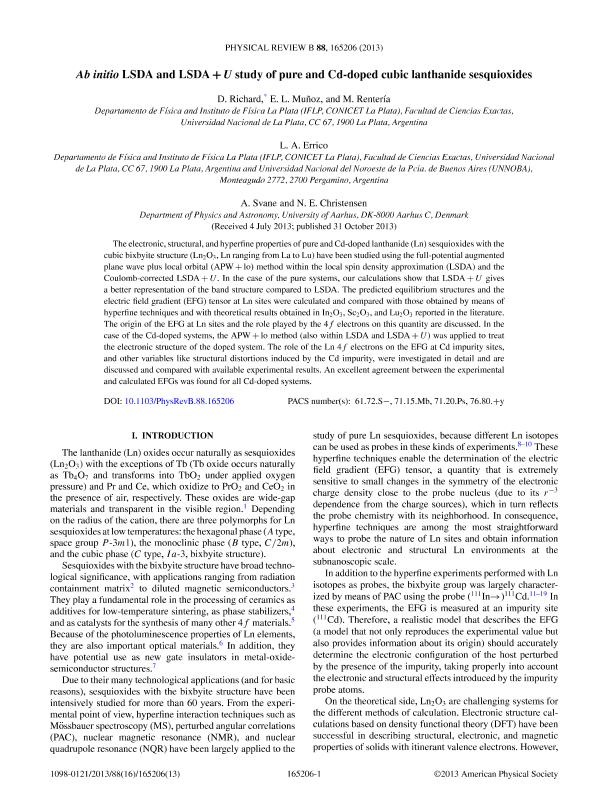Artículo
Ab initio LSDA and LSDA+U study of pure and Cd-doped cubic lanthanide sesquioxides
Richard, Diego ; Muñoz, Emiliano Luis
; Muñoz, Emiliano Luis ; Rentería, Mario
; Rentería, Mario ; Errico, Leonardo Antonio
; Errico, Leonardo Antonio ; Svane, A.; Christensen, N. E.
; Svane, A.; Christensen, N. E.
 ; Muñoz, Emiliano Luis
; Muñoz, Emiliano Luis ; Rentería, Mario
; Rentería, Mario ; Errico, Leonardo Antonio
; Errico, Leonardo Antonio ; Svane, A.; Christensen, N. E.
; Svane, A.; Christensen, N. E.
Fecha de publicación:
07/2013
Editorial:
American Physical Society
Revista:
Physical Review B
ISSN:
0163-1829
Idioma:
Inglés
Tipo de recurso:
Artículo publicado
Clasificación temática:
Resumen
The electronic, structural, and hyperfine properties of pure and Cd-doped lanthanide (Ln) sesquioxides with the cubic bixbyite structure (Ln2O3, Ln ranging from La to Lu) have been studied using the full-potential augmented plane wave plus local orbital (APW + lo) method within the local spin density approximation (LSDA) and the Coulomb-corrected LSDA + U. In the case of the pure systems, our calculations show that LSDA + U gives a better representation of the band structure compared to LSDA. The predicted equilibrium structures and the electric field gradient (EFG) tensor at Ln sites were calculated and compared with those obtained by means of hyperfine techniques and with theoretical results obtained in In2O3, Sc2O3, and Lu2O3 reported in the literature. The origin of the EFG at Ln sites and the role played by the 4f electrons on this quantity are discussed. In the case of the Cd-doped systems, the APW + lo method (also within LSDA and LSDA + U) was applied to treat the electronic structure of the doped system. The role of the Ln 4f electrons on the EFG at Cd impurity sites, and other variables like structural distortions induced by the Cd impurity, were investigated in detail and are discussed and compared with available experimental results. An excellent agreement between the experimental and calculated EFGs was found for all Cd-doped systems.
Palabras clave:
Ab Initio
,
Electronic Structure
,
Hyperfine Interactions
,
Rare Earth
Archivos asociados
Licencia
Identificadores
Colecciones
Articulos(IFLP)
Articulos de INST.DE FISICA LA PLATA
Articulos de INST.DE FISICA LA PLATA
Citación
Richard, Diego; Muñoz, Emiliano Luis; Rentería, Mario; Errico, Leonardo Antonio; Svane, A.; et al.; Ab initio LSDA and LSDA+U study of pure and Cd-doped cubic lanthanide sesquioxides; American Physical Society; Physical Review B; 88; 16; 7-2013; 165206-165206
Compartir
Altmétricas



